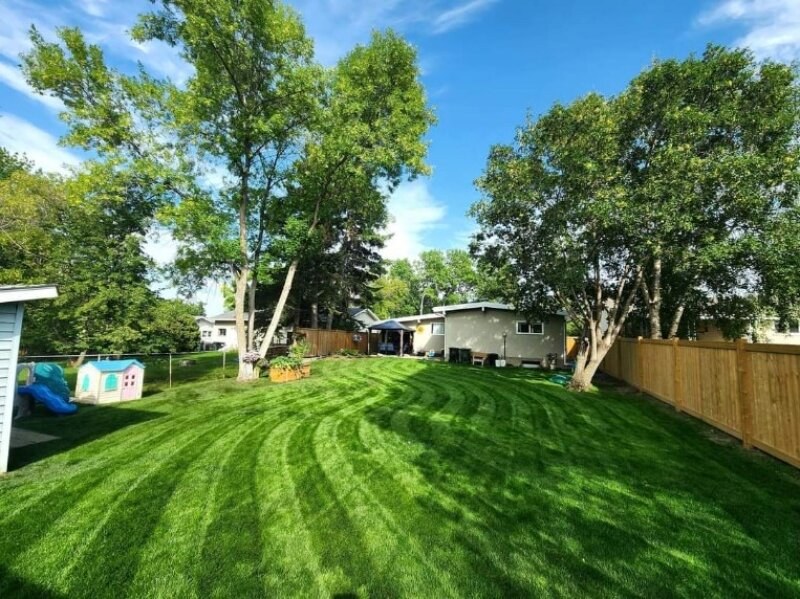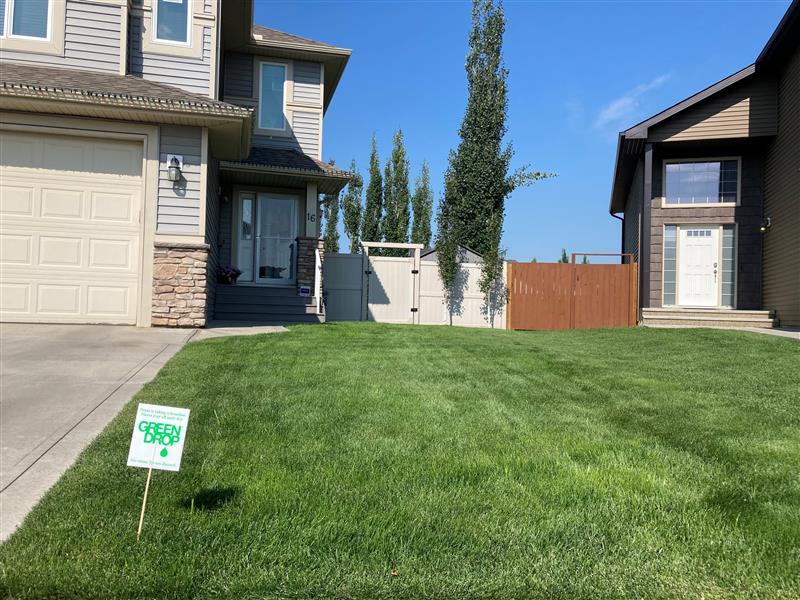Watering Your Lawn in Fall: When is It Necessary?
Reading time: 7 minutesWhile your lawn’s need for water slows down in the fall, it still requires some specialized care to decrease insect and weed infestations and get it through the colder season to give it a strong foundation for the spring.
Here’s what to know about watering your lawn in fall, and what Green Drop can do to help you get a lush, beautiful green lawn all year long.

The Role of Watering in the Fall
Typically, Canada's cool-season grass will continue to grow September through November (your typical autumn months). You may not be able to see this because most of the growth happens below the surface. The grass is now recovering from those hot/warmer summer days and plenty of foot traffic.
So how much should you water your lawn as temperatures plummet? The rule of thumb is one or two cm per week until the ground freezes. Keep in mind; if it rains, skip watering that week. Overwatering is another problem you don’t want to be dealing with.
Here’s why we recommend watering during early fall:
· Keeps the roots hydrated before temperatures drop so that they don’t die
· Prevents frost damage if you water before the ground freezes
· Keeps your lawn looking healthy
· Prevents your roots from becoming dormant
· Helps the grass blades to retain heat and moisture at the root level
When Should You Water? Key Best Practices to Follow
In the summer, you can (and should) water your lawn a lot more than in the fall. Fall watering should be done strategically to give your grass the hydration it needs without putting it at risk for freezing, fungal overgrowth, and other problems.
Here are some best practices you can follow for keeping your lawn adequately saturated:
Understand the Type of Grass You Have
Most Canadian homes have the following mix of cool-season grass:
- Kentucky bluegrass (Poa pratensis)
- Canada bluegrass (Poa compressa)
- Ryegrass (Lolium perenne)
- Tall Fescue (Festuca arundinacea)
Chances are, you’re working with a combination of the above.
Water in the Morning
It’s a good idea to water your lawn in the morning so there’s as much time as possible before nightfall for the root system to absorb the water.
However, you should only do this on days when the temperature won’t drop below freezing at any point during the day or night. This can cause the root system itself to freeze over, which can quickly kill your entire lawn.
Don’t Water Too Much
Overwatering is a bad idea in general, but can be even more detrimental to the health of your lawn in the fall and winter.
Ideally, water every few weeks for about 20 to 30 minutes to encourage roots to grow deeply. Watering more frequently but for less time can result in your grass growing shallow roots that pull up easily from the ground.
If you water your lawn too much during the cold season, your grass will be more susceptible to diseases and fungi growth, like snow mold. Plus, if it drops below freezing, your water-logged lawn could turn to ice.

Signs Your Grass Has Too Much Water
Since it’s important to watch how much you water your lawn in the fall, here are some signs your grass is on the soggy side and needs a break from watering:
- You have a lot of runoff when you water your lawn
- Your grass feels spongy or makes squishing sounds when you walk on it
- You can peel the edge of your lawn up like sod due to its shallow root system
- Mushrooms are popping up in your lawn due to fungal overgrowth
- Your grass is starting to turn yellow
Top Tips for Spring Prep
Fall and winter lawn care plays a key role in how well your grass will recover in the spring.
Here are some tips to get ready for warmer weather as the seasons change again and your grass starts to come alive.
Rake
Once the snow melts and the weather is consistently getting warmer, it’s time to rake and dethatch your lawn. This gets up any old grass that didn’t survive the winter, leftover leaves from the fall, and dead roots. If your lawn has a thick layer of thatch from poor aeration or improper watering, the beginning of spring is the perfect time to dethatch.
Aerate and Weed
Aeration helps break up compacted soil that’s hard for delicate grass roots to grow through, which encourages your lawn to develop a strong, healthy root system. It’s also a good time to get rid of any weeds that are poking through your grass prior to aerating the soil in preparation for seed and fertilizer.
Overseed
Overseeding your lawn can help get lush, beautiful grass quickly in the spring. Start by applying seed to any bare spots where the grass has thinned over the winter after you mow. This will fill your grass out in areas that need it without overdoing it in areas that already have plenty of healthy grass.
Fertilize
Next, fertilize your lawn to give it a nutritious start to the warm weather season. How you fertilize and with what fertilizer depends on the type of grass you have, your climate and geographical location, and your current soil pH.
This is when it’s helpful to work with a lawn care expert; they can test your soil and make customized recommendations based on your specific circumstances.
Mow and Water
If you haven’t already mowed your lawn before overseeding, or your grass has grown tall again, the spring season is well underway and it’s time to start your warm-weather lawn care schedule. This includes more frequent watering and mowing since your grass will start to grow faster through the summer.
Frequently Asked Questions (FAQs) About Fall Lawn Watering
What should I do if it’s going to rain?
With overwatering being more of a concern during the fall, it’s important to pay attention to the weather and when your area is expected to get rain. If it’s going to rain, or if it has recently rained, skip your watering for that month.
How many inches of water should my lawn get in the fall?
In the summer, your lawn typically needs about 1 to 2 inches of water per week to stay green and healthy. In the fall, it’s much less and you can water your lawn just a couple of inches every few weeks.
How many minutes of watering my lawn is one inch?
To give your lawn one inch of water, you should fully saturate the grass for approximately one hour, or 30 minutes for a half-inch. You can place an empty container on your lawn to keep track of how much water has collected.
Can I water my lawn at night?
In the summer, it’s often advisable to water your lawn after the sun has gone down for the day to prevent the water droplets from acting as magnifiers and burning your grass. It also allows the water to soak deep down into your lawn’s roots before the hot sun comes out again and dries it out.
In the colder months, this is generally the reverse since it gets too cold at night to water. You run a higher risk of your root system freezing, even if the weather isn’t predicted to get below 32 degrees Fahrenheit.
How Green Drop Can Help
At Green Drop, we specialize in healthy lawns for every season! Take the stress out of your lawn care and call us today at 1-877-647-3366 to learn more or to have one of our lawn care experts come to you.

